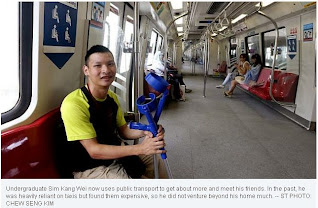Concession cards have been issued under scheme which started in July 2014
By Janice Tai, The Straits Times, 15 Dec 2014
By Janice Tai, The Straits Times, 15 Dec 2014
CLOSE to 10,000 people with disabilities have been issued concession cards that allow them to travel more cheaply on public buses and trains, under a scheme which began in July.
As of early this month, the Land Transport Authority (LTA) said it had given out about 9,800 cards so that the disabled can receive a 25 per cent fare discount and will not have to pay additional fares for distances beyond 7.2km. They can also buy a monthly pass offering unlimited travel for $60, instead of $120.
Stakeholders say that the number of people on this scheme gives an idea of public transport usage among the disabled community, though it is hard to tell if the disabled are getting out of the house more as a result, due to a lack of data.
"At least we now know that there are 10,000 people with disabilities who are mobile on trains and buses," said Dr Marissa Medjeral, executive director at the Disabled People's Association.
The LTA said it did not have ridership figures for the disabled prior to the scheme.
According to estimates from the Ministry of Social and Family Development, 3 per cent - or about 100,000 people - of Singapore's population have some form of disability.
This means that about 10 per cent of the disabled community are using public transport.
The figure is comparable to that in Britain where a 2004 survey found that 9.4 per cent of those with disabilities use trains and 3.6 per cent use buses, and in the United States where a 2002 study found that 13 per cent use buses and 6.2 per cent use trains.
However, in Australia, 40 per cent of the disabled community use public transport and most of them have concession cards.
Dr Medjeral said: "Logically, our public transport usage rate should be higher than that in the US or UK because, unlike them, all train stations here are barrier-free.
Dr Medjeral said: "Logically, our public transport usage rate should be higher than that in the US or UK because, unlike them, all train stations here are barrier-free.
"But we can't tell if more ought to be using our public transport system until we have more data on the nature of their disabilities and their usual modes of travel."
In the US, more than half a million people with disabilities do not leave their homes because of transportation difficulties.
Mr Abhimanyau Pal, executive director of SPD, which represents those with disabilities, said there are various reasons the rest do not take public transport.
"While the lower fares will encourage them to go out more often, some are unable to commute on buses and trains and have to rely on taxis or dedicated transport due to the severity of their disabilities or inaccessibility of their travel routes.
"Nevertheless, the concessionary fares will go a long way in helping them alleviate their financial burdens as expenses for persons with disabilities are usually higher."
Sales executive Ivan Lin, who has cerebral palsy and uses a wheelchair, saves about $40 a month by using the discounted monthly pass.
"I used to wheel myself from my home in Serangoon to Ang Mo Kio before boarding the bus at a later stop whenever I went to church, in order to save money, but I worry less now," said the 27-year-old.
Undergraduate Sim Kang Wei, 25, who also has cerebral palsy and uses elbow crutches to get around, is going out to meet his friends more.
"I was heavily reliant on taxis but those were expensive, so I did not venture beyond my home much," he said.
"But now the cost savings are significant, so I have been training up physically to use the train to meet my friends in the west, though I live in the east."

No comments:
Post a Comment